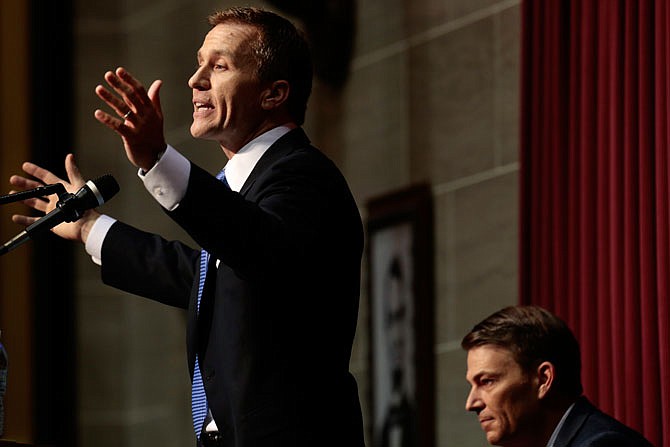Missouri's Transportation department gets most of its money each year from dedicated fuel tax revenues and federal funds.
But it also gets some state general revenue funds - and Gov. Eric Greitens' nearly $27.6 billion proposed state budget plan, released Thursday, cuts MoDOT's general revenue funding by almost $28.5 million from the amount appropriated last spring.
Acting Budget Director Dan Haug told reporters Thursday much of that cut involved the "Missouri Moves" program that was included in the current, 2016-17 budget but never really got underway.
The program was intended as a cost-share with local governments, providing "financial assistance to public and private applicants for state and local projects satisfying a transportation need," the department said in a news release last June.
But then-Gov. Jay Nixon last September withheld $20 million allocated for the program.
MoDOT Director Patrick McKenna said the governor's proposed budget cuts $25 million for the program - one of four main areas affected by Greitens' budget.
"Second is the I-70 toll study at $3 million," McKenna said. "The third area is $4.5 million for Amtrak, to pay the arreage for past years when (previous state) appropriations were insufficient to pay the contractual amount owed - plus anticipated additional amounts the state will owe for service" in the 2016-17 and 2017-18 business years.
McKenna said the fourth MoDOT program dropped from Greitens' budget proposal was capital improvements money for ports along the Missouri and Mississippi rivers.
"We expect recommended amounts will be sufficient to meet commitments," McKenna told the News Tribune.
The governor's proposed budget also trims the equivalent of 188 full-time employees (FTE) from next year's spending plan - although all those jobs currently are vacant.
Still, MoDOT had 100 of those jobs.
"We worked with the office of administration on the FTE reduction," McKenna said. "It is important to remember the FTE count is a calculation of hours worked.
"We will manage the FTE reduction by managing our temporary employees and overtime, as we have for many years."
Even with the general revenue cuts, Transportation has an overall $62.1 million increase, including an estimated $24.7 million in federal funds.
Agriculture is the one of the state's smallest departments.
The governor's proposed budget cuts $15,307,140 from the agency's budget - including more than $9.62 million from the director's office budget.
"I think the biggest part of that would be a reduction in the payments for the biodiesel producers," Haug said.
The state for years has offered payments to organizations producing diesel fuel from natural products like corn, but in years where the state has had revenue issues, those payments sometimes have been withheld and not paid.
Haug said other parts of the Agriculture cuts are "some of the restrictions that were put in place this year that were carried forward as permanent core cuts" in the governor's proposed budget.
Missouri's Higher Education department takes the biggest total hit in Greitens' proposed budget for the 2017-18 state business year.
With its 10 percent cut in the core budgets for all of Missouri's public colleges and universities - two-year and four-year schools alike - the department would get more than $116.2 million less in general revenue in the business year that begins July 1 than in the current budget.
Those cuts include more than $2.54 million less for Lincoln University in the coming budget year and $334,751 less for State Technical College in Linn.
But some of the Higher Education cuts involve a transfer of programs to other agencies.
For example, Haug said last week, "The Guaranteed Student Loan Program - which was in the Department of Higher Ed - has been moved from the state administration into other areas.
"So there were appropriations there that were no longer needed. That really won't affect any services."
Higher Education's total appropriation - including federal funds and other funds that come into the state - is more than $159 million less than this current year.
The state's Health and Senior Services department took the second biggest cut in the proposed budget from this year - more than $28.5 million less in general revenue funds than last year, and almost $54.2 million less in total funds.
Haug said the proposed budget includes $572 million in core cuts.
"The governor's talked about $700 million - which would (include) the $146 million he's had to restrict this year," Haug said, "plus those cuts less than lawmakers appropriated a year ago."
Still, the new budget proposes to spend about 1.1 percent more in the business year that starts July 1 than in the current year.
"That's because you have mandatory cost increases, and those kind of things that we have to spend by law," Haug said.
Because of those mandates, the state Social Services department's spending is proposed to grow the most of all state agencies, with a more than $373 million increase.

